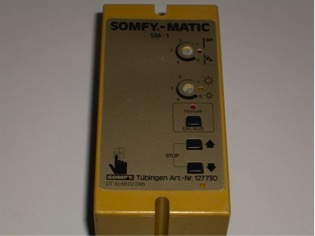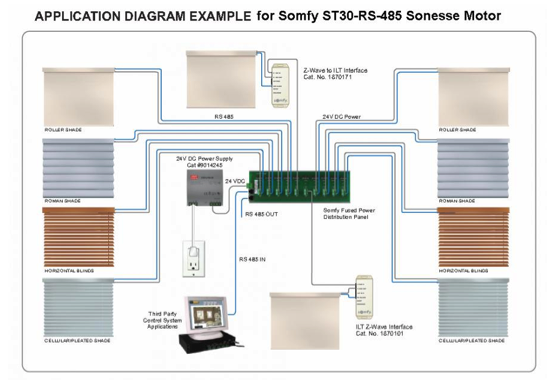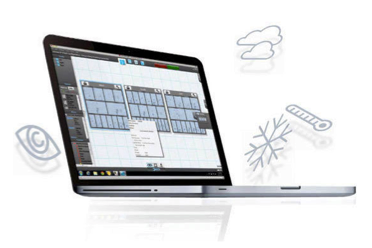Interview with Somfy Systems, motorized shade experts
Somfy Systems is the world leader in motorized and automated shades for the window covering industry. They manufacture motors and intelligent systems for all types of blinds, shades, awnings and rolling shutters. Since motorization and automation are the driving force in engineered shading systems, it only makes sense to include such important content. My interview is with two of Somfy’s leading individuals with architectural and engineering experience: Russell Horowitz the Architectural Specification Manager in the Northeast and Ty Saville the Architectural/Engineering Market Specifications Manager.
NG: How did Somfy get involved selling shade motors?
TS & RH: Somfy began in 1750 in a French valley that borders Switzerland manufacturing parts for Swiss watches. This region is where the Somfy name originates. Somfy is an acronym; it stands for Societe d’Outillage Mecanique du Faucigny that translates to Mechanical Tooling Company of Faucigny. By 1868, the company had expanded and now manufactured a wide range of products and components including fishing reels and rods. In 1969 a local awning and shutter manufacturer contacted various companies in the area looking for a solution to power their products. Somfy was the only company able to manufacture a prototype. This was the first step in a whole new direction for the company. In 1977 Somfy expanded to the United States. Manually retractable awnings were commonplace so motorization was a welcomed feature. Motorized projection screens and interior shades quickly followed. Somfy first touched on home automation in 1981 with the launch of the “Somfy-matic”, the first weather controlled awning and shutters, capable of sensing weather conditions and automatically adjusting awnings and shutters appropriately. Today we are helping to create smart homes and workplaces. Smartphones or tablets can remotely control Somfy products; additionally, our products integrate into popular home automation systems including Crestron, Honeywell, and AT&T.

NG: What are the major automation strategies that Somfy focuses on?
TS & RH: Somfy is always looking at ways to expand the automation and motorization market place. To do this we divide up the resources into residential and commercial, as there are different drivers in both markets. The Somfy residential team has been promoting the home automation message in an effort to educate the end users in the benefits of automation within the home. This used to be out of reach for most consumers due to technology and cost limitations, with this information Somfy has developed more intuitive patented technology and looked at ways to be more price competitive. This has had a positive impact on reaching a larger number of consumers over recent years. With the rapid growth in this industry, Somfy’s main strategy is to continue working with the leading brands in automation to ensure seamless integration for our users. Somfy has interfaces that control automated shades; these are available in technologies such as, RS232, RS485, BACnet, Z-Wave, ZigBee or WiFi. Somfy’s Commercial Building Solutions offer a wide range of intelligent motors and controls such as Animeo IP that optimize the utilization of natural light in your commercial workspace. Somfy’s Commercial Specification team is LEED accredited and will support all aspects of any project, from specification through commissioning. From basic smart phone control, to advance automated building management solutions Somfy has a system to meet today’s automation demands.
 NG: How does Somfy systems provide solutions for LEED?
NG: How does Somfy systems provide solutions for LEED?
TS & RH: Somfy Systems is a member of the USGBC and is proud to offer our solutions to earn LEED credits. Somfy solutions for building automation of shading and natural ventilation devices create a bioclimatic façade. By interacting with outside elements to best utilize natural light and air while providing thermal and visual comfort, Somfy solutions contribute to energy savings, occupant comfort, and design innovation. Somfy solutions have a high impact on the available points attributed to daylighting (Indoor Environmental Quality Credit 7 – up to 3 points available) a certain percentage of the building. There are many other points available related to automated window coverings but they would need to work in conjunction with the lighting and HVAC system within the building. Some potential points include light pollution reduction (Sustainable Sites Credit 6 – 1 point available) thermal comfort of occupants (Indoor Environmental Quality Credit 5 -1 point available) and providing quality views (Indoor Environmental Quality Credit 8 – up to 2 points available). Somfy has the ability to contribute to the optimization of the energy performance within the entire building by influencing how the building envelope interacts with the environment – due to points being delivered against energy saving percentage all systems within the building must work in unison to achieve the available 18 points. (Energy & Atmosphere Credit 2 – 18 points available against 50% energy savings). The overall LEED objective is to achieve a truly holistic approach in building design to ensure all systems will work together to reduce the energy footprint and increase occupant comfort. Automated window coverings powered by Somfy have the ability to provide LEED points necessary to help projects achieve certified, silver, gold, or platinum status. To gain the available LEED points buildings model data needs to be submitted to claim the points from LEED.
NG: What is the future for Somfy products as Architects focus on sustainable buildings? 
TS & RH: Somfy’s focus on developing innovative products which promote more energy efficient buildings started many years ago with the Somfy-matic and continues today with Animeo IP. Our systems are calibrated to maximize occupant comfort while enhancing the visual environment, minimizing solar glare and heat gain, and providing UV protection. Somfy’s natural light control and automation systems are scalable in design; offered in low voltage, line voltage or wireless options; and are perfect for projects of any size or budget. This continued approach has kept Somfy solidified as the leader in the automated window treatment market. As this market has evolved, Somfy has improved the tools available to its customers to help solidify their position with their clients. This includes partnerships with companies such as Integrated Environmental Studies (IES) who provide integrated three-dimensional energy models, which document the energy load reduction on a building. These models allow for building owners and decision makers to compare energy performance results of using different types of glass with Somfy automated sun-shading devices, thus allowing the ability to make the correct choice for the building in question.
Somfy’s focus on sustainable buildings is highlighted with the release of Animeo IP. Animeo IP is a total solar management system utilizing Somfy-powered intelligent motorized window coverings as well as digital keypads and weather sensors. The system’s controllers, sensors and keypads can be  added to both new and existing Somfy Digital Network installations for comprehensive solar management as either a stand-alone solution or integrated into third party control systems. An intuitive user interface allows for simplified commissioning, building management and technical support, featuring drag-and-drop programming, motor auto discovery, and at-a-glance real-time system status updates. Animeo IP automatically manages motorized window coverings reducing the dependency on artificial light, allowing more natural light for increased visual comfort of occupants as well as energy savings. Automated motorized window coverings are raised and lowered according to changes in outdoor weather conditions and indoor comfort needs based on commands from sensors, pre-programmed settings, or local occupant controls. The Animeo IP’s solar tracking function is automated to ensure the reality of energy savings – 62% of energy use in commercial buildings attributed to lighting and HVAC systems (USEIA 2003), this drives decision makers to increase energy efficiency with automation of critical systems such as facade management.
added to both new and existing Somfy Digital Network installations for comprehensive solar management as either a stand-alone solution or integrated into third party control systems. An intuitive user interface allows for simplified commissioning, building management and technical support, featuring drag-and-drop programming, motor auto discovery, and at-a-glance real-time system status updates. Animeo IP automatically manages motorized window coverings reducing the dependency on artificial light, allowing more natural light for increased visual comfort of occupants as well as energy savings. Automated motorized window coverings are raised and lowered according to changes in outdoor weather conditions and indoor comfort needs based on commands from sensors, pre-programmed settings, or local occupant controls. The Animeo IP’s solar tracking function is automated to ensure the reality of energy savings – 62% of energy use in commercial buildings attributed to lighting and HVAC systems (USEIA 2003), this drives decision makers to increase energy efficiency with automation of critical systems such as facade management.
{{cta(‘7fc41619-393a-44f3-bfac-65f105d8a90e’)}}
